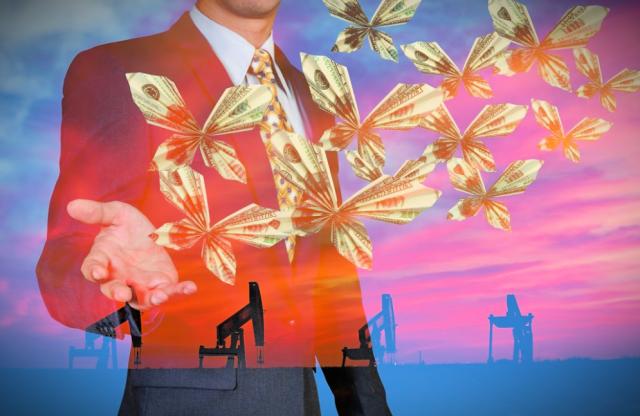
To garner investor favor, cash flow is paramount. But the preferred method of delivery is straight into investors' hands. (Source: Hart Energy/Shutterstock.com)
[Editor's note: A version of this story appears in the November 2019 edition of Oil and Gas Investor. Subscribe to the magazine here.]
At the Scotia Howard Weil investor symposium in March 2018, held a year and a half ago as investor support faltered, E&P CEOs in succession pounded the podium defiantly defending their shareholder value and new promises of free cash flow over growth. Today, those same E&Ps are meticulously, painfully and humbly metamorphosing from ravenous, capital-consuming caterpillars to value-oriented, cash-flowing butterflies. The lingering question: Will that be enough to catch the eyes of those investors once again?
More needs to be done, claim sell-side analysts.
Simmons Energy analyst Ryan Todd laments that a large and growing number of investors have lost faith that the E&P sector can outperform in a $50 to $55 WTI world, despite the firm’s prediction of a 3% free-cash-flow yield for its covered companies at $55. It “just isn’t compelling enough to get generalists off the sidelines,” he said in an Oct. 11 report. “Things are heading in the right direction, but it is a LONG and brutal slog with a ways to go.”
Cowen analyst David Deckelbaum in an Oct. 7 report said E&P execs are “unsurprisingly frustrated” with year-to-date stock performances despite a laser focus on free-cash-flow generation. Still, “management teams are resolute in their focus on capital efficiency heading into 2020 that may call for lower activity than anticipated.”
Deckelbaum suggested E&Ps should match the S&P 500 growth benchmark of 5% with a 5%-7% FCF yield. He also anticipated guided 2020 budgets will be lower than Street expectations as companies take a wait-and-see approach on how their equities perform in a second year of free-cash-flow pursuit.
Joe Allman, a Baird analyst, in early October said more investors “seem convinced that E&P capital discipline is here to stay.” He predicted that free-cash-flow yields for the top 50 E&Ps would double in 2020 over 2019 levels.
But Pearce Hammond, a Simmons analyst as well, went further. He indicated the investment community is demanding “a tangible line of sight to robust free-cash-flow yields and well-above-average dividend yields,” emphasizing the importance of dividends. “In lieu of the race to zero-bound/negative interest rates, investors are increasingly attracted to sustainable and robust dividend streams,” he said.
Why dividends? Dividends are cash in hand, and cash is king.
Investors want to be paid while they wait for energy fundamentals to improve, Hammond said. Investors distrust management capital allocation policies and prefer to get the cash directly. Recent buyback programs have sent shareholder cash “into the bonfire” as equity values further collapsed. And the globe is starved for yield as the 10-year U.S. Treasury hangs at 1.65%.
While $50 oil prices might be just enough to garner a slight free cash flow pared with a sub-$2 dividend yield, that’s not good enough to entice investors, he noted, especially with the volatility that clouds the macro outlook.
Unfortunately, “the energy sector currently does not provide a depth of names delivering attractive and/or sustainable yields,” he said, “but we expect that to improve in the years ahead as companies moderate spending, focus on generating free cash flow and increasingly return cash to shareholders through dividends rather than share buybacks.”
Hammond believes a “battleground” is emerging between investors and management teams around the buybacks vs. dividends argument, believing investors “far prefer” a sustainable dividend with headroom and a competitive yield. “While we understand the dollar cost averaging argument that some management teams espouse regarding buyback programs, it is hard to face investors after having repurchased shares at much higher prices. Unless energy equity performance meaningfully improves, we believe investors will increasingly reject management teams’ desire to repurchase stock at the expense of a higher dividend.”
His response to management teams “reluctant to get strangled” by too high of a dividend: Pay a special dividend annually if cash flow supports it.
To garner investor favor, cash flow is paramount. But the preferred method of delivery is straight into investors' hands in the form of a cash dividend large enough to entice. More cash flow might be required.
“Improved alignment with new investors will be forthcoming when sustainable and high dividend yields underpin share prices and the oil price conviction improves,” said Hammond. “Fundamentally reforming an industry and regaining investor sponsorship is likely to be a long-term endeavor—welcome to the maturation phase of the industry, and hail goodbye to the frenzied embryonic, anything-goes phase.”
Recommended Reading
CEO: Continental Adds Midland Basin Acreage, Explores Woodford, Barnett
2024-04-11 - Continental Resources is adding leases in Midland and Ector counties, Texas, as the private E&P hunts for drilling locations to explore. Continental is also testing deeper Barnett and Woodford intervals across its Permian footprint, CEO Doug Lawler said in an exclusive interview.
Chevron Hunts Upside for Oil Recovery, D&C Savings with Permian Pilots
2024-02-06 - New techniques and technologies being piloted by Chevron in the Permian Basin are improving drilling and completed cycle times. Executives at the California-based major hope to eventually improve overall resource recovery from its shale portfolio.
TPH: Lower 48 to Shed Rigs Through 3Q Before Gas Plays Rebound
2024-03-13 - TPH&Co. analysis shows the Permian Basin will lose rigs near term, but as activity in gassy plays ticks up later this year, the Permian may be headed towards muted activity into 2025.
US Gas Rig Count Falls to Lowest Since January 2022
2024-03-22 - The combined oil and gas rig count, an early indicator of future output, fell by five to 624 in the week to March 22.
Texas Earthquake Could Further Restrict Oil Companies' Saltwater Disposal Options
2024-04-12 - The quake was the largest yet in the Stanton Seismic Response Area in the Permian Basin, where regulators were already monitoring seismic activity linked to disposal of saltwater, a natural byproduct of oil and gas production.



